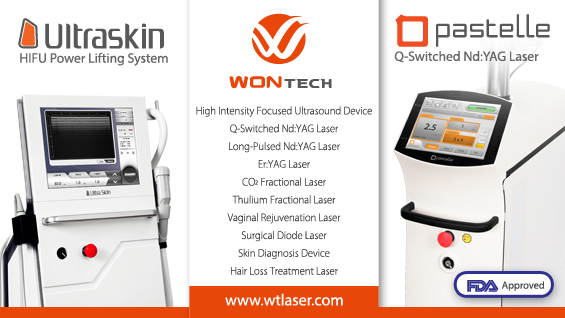Physicians, including dermatologists, used this approach to treat melasma, solar lentigines, acquired, bilateral nevus of Ota-like macules (ABNOM), post-inflammatory hyperpigmentation, or dark skin tone. Some even performed this procedure every 1 or 2 weeks and called this procedure “Lunch Beauty Makeover” (午休美容), similar to IPL. Others like TV shopping channels also sold these treatments and brought up the special names like “Black Face/Porcelain Doll”(黑瓷娃娃) or “Porcelain Doll”(白瓷娃娃) to emphasize the unique characters of this procedure.
If the procedure is prepared in advance by application of carbon suspension solutionon the face to increase the absorption of laser energy, it is known as the “Black-faced Doll”(黑臉娃娃) or “Black Porcelain Doll”. Many of the current procedures with attractive titles on the market are basically Q-switched 1,064 nm Nd-YAG lasers related procedures.
Some people argued that the application of carbon suspension solution will be better than non-application. They proposed that the carbon can be heated and blasted over the epidermal surface as a peeling agent after absorbing laser beam. Therefore, the effect of first pass in laser toning is actually the peeling effect through heated carbon particles.
The effect of second pass is the new collagen formation and destruction of dermal pigment by thermal injury and selective photothermolysis to the dermis, respectively. This thermal injury with collagen regeneration is the reason for the improvement of pore size, skin texture, and skin tone.
However, the study of Dr. Mei-Ching Lee et al. from Taiwan showed there was no statistically difference in the improvement of skin conditions (including skin texture, skin tone, pore size, and sebum secretion) even after the application of topical carbon solution. Since then, the application of carbon suspension is gradually decreasing and replaced by using lasers only to achieve similar results.
[Advertisement] Ultra Skin/Pastelle – Manufacturer: WONTECH(www.wtlaser.com)
The Treatment
Today, most of the laser toning in Taiwan is typically performed by multiple laser passes without carbon application. Treatment consisted of three to five passes of the laser until a clinical end point of erythema with slightly pinpoint bleeding was observed.
Some other modified protocol, for example, used whole face scanning with 8-mm spot size, 2.0 J/cm2 for one pass, 6-mm spot size, 3.5 J/cm2 for second pass, and ended with 4-mm spot size, 3.2 J/cm2 scanningas final pass for full face and deep pigmented area. The end point would be mild erythema and swelling. Petechiae should be avoided if other adjunctive treatment like ultrasonic application of vitamin C was performed.
A similar study by Dr. Mei-Ching Lee et al. from Taiwan proved significant improvement with the combination of 1,064nm Q-switched Nd-YAG laser treatment with ultrasonic application of topical vitamin C compared to laser monotherapy. The improvement was noted more pronounced during second to fourth sessions.
-To be continued





















